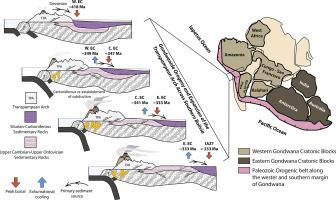Gondwana Research ( IF 6.1 ) Pub Date : 2021-03-14 , DOI: 10.1016/j.gr.2021.03.002 Ryan B. Anderson , Sean P. Long , Brian K. Horton , Amanda Z. Calle , Emmanuel Soignard

|
A widespread unconformity between Ordovician metasedimentary rocks and nonmetamorphosed Mesozoic sedimentary rocks across the Eastern Cordillera of Bolivia provides evidence for significant pre-Late Cretaceous deformation and erosion. In this paper, we refine the middle to late Paleozoic tectonic history of the central Andean segment of Gondwana's western margin. We combine Raman spectroscopy of carbonaceous material (RSCM) thermometry with semi-quantitative deformation temperature estimates from quartz recrystallization microstructures and published illite crystallinity values from Cambrian-Devonian sedimentary rocks that span the Eastern Cordillera of southern Bolivia at ~21°S. Estimates of peak temperature and deformation temperature range primarily between ~220 and ~ 400 °C and show a general increase with depth that defines a metamorphic field gradient between ~37 and ~ 47 °C/km. Temperatures obtained from Ordovician rocks directly below the unconformity require erosion of a > ~5 km overburden prior to the Late Cretaceous, which was likely accomplished by a combination of distributed cleavage development and Paleozoic folding and thrust faulting revealed from cross-section reconstructions. The peak temperature data are incorporated into thermal models along with published illite K Ar, zircon (U
Ar, zircon (U Th)/He, and zircon fission-track cooling ages that refine the timing of Paleozoic orogenesis in the central Andes. We interpret shortening-related flexural subsidence driven by cratonward growth of a pre-Andean orogenic wedge along the western margin of Gondwana, with peak temperature conditions attained during eastward advance of a foreland basin between ~420 and ~ 318 Ma during the Devonian-Carboniferous Gondwanide Orogeny. Erosional exhumation between ~352 and ~ 294 Ma was the result of continued growth and eastward expansion of the associated Transpampean tectonic highland across the Eastern Cordillera. The growth of this pre-Andean contractional orogen coincided with global plate reorganization and the reestablishment of subduction and arc magmatism along the western margin of Gondwana, as indicated by a significant influx of Carboniferous arc-related detritus into the foreland basin system.
Th)/He, and zircon fission-track cooling ages that refine the timing of Paleozoic orogenesis in the central Andes. We interpret shortening-related flexural subsidence driven by cratonward growth of a pre-Andean orogenic wedge along the western margin of Gondwana, with peak temperature conditions attained during eastward advance of a foreland basin between ~420 and ~ 318 Ma during the Devonian-Carboniferous Gondwanide Orogeny. Erosional exhumation between ~352 and ~ 294 Ma was the result of continued growth and eastward expansion of the associated Transpampean tectonic highland across the Eastern Cordillera. The growth of this pre-Andean contractional orogen coincided with global plate reorganization and the reestablishment of subduction and arc magmatism along the western margin of Gondwana, as indicated by a significant influx of Carboniferous arc-related detritus into the foreland basin system.
中文翻译:

安第斯中部晚古生代刚德尼德变形:来自玻利维亚南部的RSCM测温和热模拟的见解
横跨玻利维亚东部山脉的奥陶纪准沉积岩与非变质中生代沉积岩之间普遍存在不整合,为白垩纪晚期前的大范围变形和侵蚀提供了证据。在本文中,我们对冈瓦纳西缘中部安第斯山脉中段的中古晚期构造历史进行了细化。我们将碳质材料(RSCM)测温的拉曼光谱与石英重结晶微结构的半定量变形温度估算值相结合,并公布了横跨玻利维亚南部东山脉的寒武纪-德文统沉积岩的伊利石结晶度值,温度约为21°S。峰值温度和形变温度范围的估算值主要在约220至〜400°C之间,并且随深度的增加而总体增加,这定义了约37至〜47°C / km的变质场梯度。从不整合面正下方的奥陶纪岩石获得的温度要求在白垩纪晚期之前对> 5 km的覆盖层进行侵蚀,这很可能是通过分散的裂隙发育和古生代褶皱以及断层重建所揭示的逆冲断层的组合来完成的。峰值温度数据与已发布的伊利石K一起合并到热模型中 这很可能是由断层重建揭示的分布式分裂发育与古生代褶皱和逆冲断层的结合而完成的。峰值温度数据与已发布的伊利石K一起合并到热模型中 这很可能是由断层重建揭示的分布式分裂发育与古生代褶皱和逆冲断层的结合而完成的。峰值温度数据与已发布的伊利石K一起合并到热模型中 氩,锆石(U
氩,锆石(U Th)/ He和锆石裂变径迹的冷却时代,完善了安第斯山脉中部古生代造山的时间。我们解释了在冈瓦纳西部边缘安第斯前造山楔沿克拉通向克拉通方向生长所引起的与收缩有关的挠曲沉降,在泥盆纪-石炭纪冈维尼德前陆盆地向东推进时,在约420至约318 Ma之间达到了峰值温度条件。造山运动。〜352和〜294 Ma之间的侵蚀性掘尸是整个东部山脉通过相关的跨太平洋构造高地持续增长和向东扩展的结果。这个安第斯前收缩造山带的生长与全球板块重组以及冈瓦纳西部边缘俯冲和弧岩浆活动的重建相吻合,
Th)/ He和锆石裂变径迹的冷却时代,完善了安第斯山脉中部古生代造山的时间。我们解释了在冈瓦纳西部边缘安第斯前造山楔沿克拉通向克拉通方向生长所引起的与收缩有关的挠曲沉降,在泥盆纪-石炭纪冈维尼德前陆盆地向东推进时,在约420至约318 Ma之间达到了峰值温度条件。造山运动。〜352和〜294 Ma之间的侵蚀性掘尸是整个东部山脉通过相关的跨太平洋构造高地持续增长和向东扩展的结果。这个安第斯前收缩造山带的生长与全球板块重组以及冈瓦纳西部边缘俯冲和弧岩浆活动的重建相吻合,


























 京公网安备 11010802027423号
京公网安备 11010802027423号